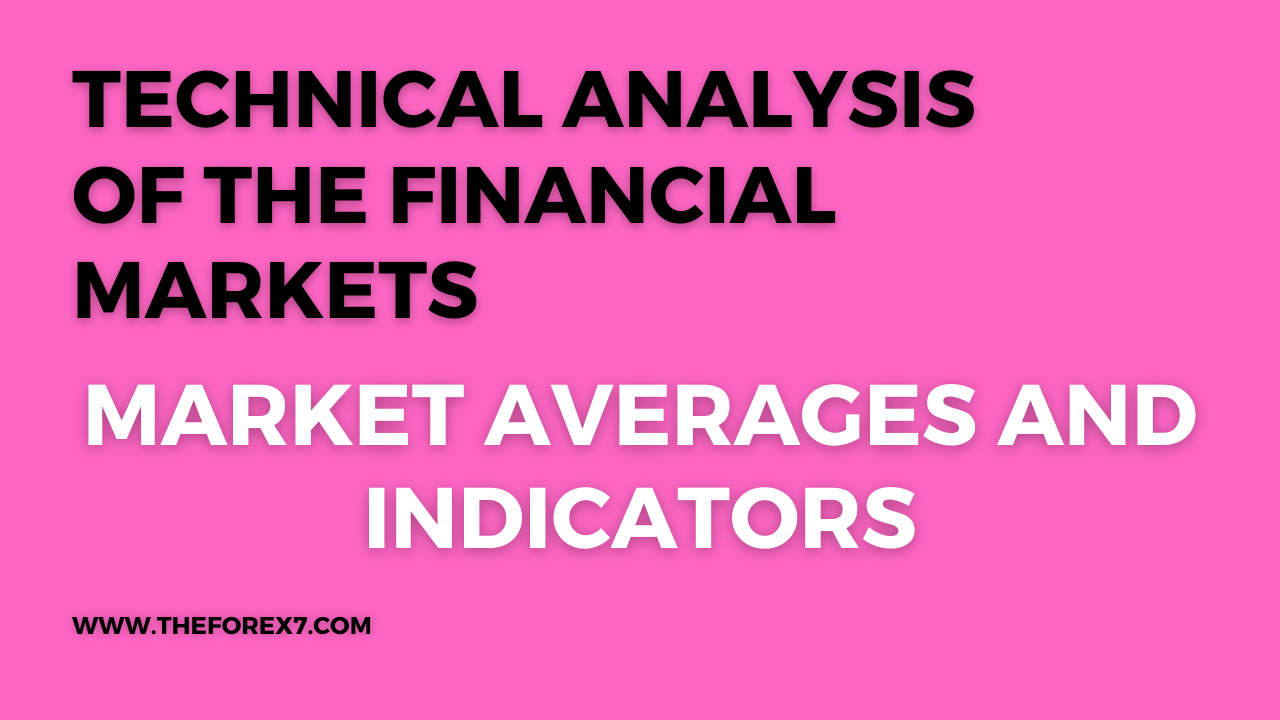Less Reliance On Market Averages And Indicators
Specific Technical Tools, criticism of technical approach, self fulfilling prophecy, Random walk theory
Course: [ Technical Analysis of the Financial Markets : Chapter 1: Philosophy of Technical Analysis ]

Stock market analysis is based heavily on the movement of broad market averages—such as the Dow Jones Industrial Average or the S&P 500.
LESS RELIANCE ON MARKET AVERAGES AND INDICATORS
Stock
market analysis is based heavily on the movement of broad market averages—such
as the Dow Jones Industrial Average or the S&P 500. In addition, technical
indicators that measure the strength or weakness of the broader market—like the
NYSE advance-decline line or the new highs-new lows list—are heavily employed.
While commodity markets can be tracked using measures like the Commodity
Research Bureau Futures Price Index, less emphasis is placed on the broader
market approach. Commodity market analysis concentrates more on individual market
action. That being the case, technical indicators that measure broader
commodity trends aren't used much. With only about 20 or so active commodity
markets, there isn't much need.
Specific Technical Tools
While
most of the technical tools originally developed in the stock market have some
application in commodity markets, they are not used in the exact same way. For
example, chart patterns in futures often tend not to form as fully as they do
in stocks.
Futures
traders rely more heavily on shorter term indicators that emphasize more
precise trading signals. These points of difference and many others are
discussed later in this book.
Finally,
there is another area of major difference between stocks and futures. Technical
analysis in stocks relies much more heavily on the use of sentiment indicators
and flow of funds analysis. Sentiment indicators monitor the performance of
different groups such as odd letters, mutual funds, and floor specialists.
Enormous importance is placed on sentiment indicators that measure the overall
market bullishness and bearishness on the theory that the majority opinion is
usually wrong. Flow of funds analysis refers to the cash position of different
groups, such as mutual funds or large institutional accounts. The thinking here
is that the larger the cash position, the more funds that are available for
stock purchases.
Technical
analysis in the futures markets is a much purer form of price analysis. While
contrary opinion theory is also used to some extent, much more emphasis is
placed on basic trend analysis and the application of traditional technical
indicators.
SOME CRITICISMS OF THE TECHNICAL APPROACH
A
few questions generally crop up in any discussion of the technical approach.
One of these concerns is the self-fulfilling prophecy. Another is the question
of whether or not past price data can really be used to forecast future price
direction. The critic usually says something like: "Charts tell us where the market has been, but can't tell
us where it is going." For
the moment, we'll put aside the obvious answer that a chart won't tell you
anything if you don't know how to read it. The Random Walk Theory questions
whether prices trend at all and doubts that any forecasting technique can beat
a simple buy and hold strategy. These questions deserve a response.
The Self-Fulfilling Prophecy
The
question of whether there is a self-fulfilling prophecy at work seems to bother
most people because it is raised so often. It is certainly a valid concern,
but of much less importance than most people realize. Perhaps the best way to
address this question is to quote from a text that discusses some of the
disadvantages of using chart patterns:
- The
use of most chart patterns has been widely publicized in the last several years.
Many traders are quite familiar with these patterns and often act on them in
concert. This creates a "self-fulfilling
prophecy," as waves of buying or
selling are created in response to "bullish" or
"bearish” patterns. . .
- Chart patterns are almost completely subjective. No study has yet succeeded in mathematically quantifying any of them. They are literally in the mind of the beholder.... (Teweles et al.)
These
two criticisms contradict one another and the second point actually cancels
out the first. If chart patterns are "completely subjective" and "in the mind of the beholder," then it is hard to imagine how
everyone could see the same thing at the same time, which is the basis of the
self-fulfilling prophecy. Critics of charting can't have it both ways. They
can't, on the one hand, criticize charting for being so objective and obvious
that everyone will act in the same way at the same time (thereby causing the
price pattern to be fulfilled), and then also criticize charting for being too
subjective.
The
truth of the matter is that charting is very subjective. Chart reading is an
art. (Possibly the word "skill" would be more to the point.) Chart
patterns are seldom so clear that even experienced chartists always agree on
their interpretation. There is always an element of doubt and disagreement. As
this book demonstrates, there are many different approaches to technical
analysis that often disagree with one another.
Even
if most technicians did agree on a market forecast, they would not all
necessarily enter the market at the same time and in the same way. Some would
try to anticipate the chart signal and enter the market early. Others would
buy the "breakout" from a given pattern or indicator.
Still others would wait for the pullback after the breakout before taking
action. Some traders are aggressive; others are conservative. Some use stops to
enter the market, while others like to use market orders or resting limit
orders. Some are trading for the long pull, while others are day trading.
Therefore, the possibility of all technicians acting at the same time and in
the same way is actually quite remote.
Even
if the self-fulfilling prophecy were of major concern, it would probably be "self-correcting" in
nature. In other words, traders would rely heavily on charts until their
concerted actions started to affect or distort the markets. Once traders
realized this was happening, they would either stop using the charts or adjust
their trading tactics. For example, they would either try to act before the
crowd or wait longer for greater confirmation. So, even if the self-fulfilling
prophecy did become a problem over the near term, it would tend to correct
itself.
It
must be kept in mind that bull and bear markets only occur and are maintained
when they are justified by the law of supply and demand. Technicians could not
possibly cause a major market move just by the sheer power of their buying and
selling. If this were the case, technicians would all become wealthy very
quickly.
Of
much more concern than the chartists is the tremendous growth in the use of
computerized technical trading systems in the futures market. These systems are
mainly trend-following in nature, which means that they are all programmed to
identify and trade major trends. With the growth in professionally managed
money in the futures industry, and the proliferation of multimillion-dollar
public and private funds, most of which are using these technical systems,
tremendous concentrations of money are chasing only a handful of existing
trends. Because the universe of futures markets is still quite small, the
potential for these systems distorting short term price action is growing.
However, even in cases where distortions do occur, they are generally short
term in nature and do not cause major moves.
Here
again, even the problem of concentrated sums of money using technical systems
is probably self-correcting. If all of the systems started doing the same thing
at the same time, traders would make adjustments by making their systems either
more or less sensitive.
The
self-fulfilling prophecy is generally listed as a criticism of charting. It
might be more appropriate to label it as a compliment. After all, for any
forecasting technique to become so popular that it begins to influence events,
it would have to be pretty good. We can only speculate as to why this concern
is seldom raised regarding the use of fundamental analysis.
Can the Past Be Used to Predict the Future?
Another
question often raised concerns the validity of using past price data to predict
the future. It is surprising how often critics of the technical approach bring
up this point because every known method of forecasting, from weather
predicting to fundamental analysis, is based completely on the study of past
data. What other kind of data is there to work with?
The
field of statistics makes a distinction between descriptive statistics and
inductive statistics. Descriptive statistics refers to the graphical
presentation of data, such as the price data on a standard bar chart. Inductive
statistics refers to generalizations, predictions, or extrapolations that are
inferred from that data. Therefore, the price chart itself comes under the
heading of the descriptive, while the analysis technicians perform on that
price data falls into the realm of the inductive.
As
one statistical text puts it, "The
first step in forecasting the business or economic future consists, thus, of
gathering observations from the past."
(Freund and Williams) Chart analysis is just another form of time series
analysis, based on a study of the past, which is exactly what is done in all
forms of time series analysis. The only type of data anyone has to go on is
past data. We can only estimate the future by projecting past experiences into
that future.
So
it seems that the use of past price data to predict the future in technical
analysis is grounded in sound statistical concepts. If anyone were to
seriously question this aspect of technical forecasting, he or she would have
to also question the validity of every other form of forecasting based on
historical data, which includes all economic and fundamental analysis.
RANDOM WALK THEORY
The
Random Walk Theory, developed and nurtured in the academic community, claims
that price changes are "serially
independent" and
that price history is not a reliable indicator of future price direction. In a
nutshell, price movement is random and unpredictable. The theory is based on
the efficient market hypothesis, which holds that prices fluctuate randomly
about their intrinsic value. It also holds that the best market strategy to
follow would be a simple "buy
and hold" strategy
as opposed to any attempt to "beat
the market."
While
there seems little doubt that a certain amount of randomness or "noise" does
exist in all markets, it's just unrealistic to believe that all price movement
is random. This may be one of those areas where empirical observation and
practical experience prove more useful than sophisticated statistical
techniques, which seem capable of proving anything the user has in mind or
incapable of disproving anything. It might be useful to keep in mind that
randomness can only be defined in the negative sense of an inability to uncover
systematic patterns in price action. The fact that many academics have not been
able to discover the presence of these patterns does not prove that they do
not exist.
The
academic debate as to whether markets trend is of little interest to the
average market analyst or trader who is forced to deal in the real world where
market trends are clearly visible. If the reader has any doubts on this point,
a casual glance through any chart book (randomly selected) will demonstrate the
presence of trends in a very graphic way. How do the "random walkers" explain the persistence of these
trends if prices are serially independent, meaning that what happened
yesterday, or last week, has no bearing on what may happen today or tomorrow?
How do they explain the profitable "real life" track records of many
trend following systems?
How,
for example, would a buy and hold strategy fare in the commodity futures
markets where timing is so crucial? Would those long positions be held during
bear markets? How would traders even know the difference between bull and bear
markets if prices are unpredictable and don't trend? In fact, how could a bear
market even exist in the first place because that would imply a trend? (See Figure 1.3.)

Figure
1.3 A “random walker” would have a tough time convincing a holder of gold
bullion that there’s no real trend on this chart.
It
seems doubtful that statistical evidence will ever totally prove or disprove
the Random Walk Theory. However, the idea that markets are random is totally
rejected by the technical community. If the markets were truly random, no
forecasting technique would work. Far from disproving the validity of the
technical approach, the efficient market hypothesis is very close to the
technical premise that markets discount everything. The academics, however,
feel that because markets quickly discount all information, there's no way to
take advantage of that information. The basis of technical forecasting, already
touched upon, is that important market information is discounted in the market
price long before it becomes known. Without meaning to, the academics have
very eloquently stated the need for closely monitoring price action and the
futility of trying to profit from fundamental information, at least over the
short term.
Finally,
it seems only fair to observe that any process appears random and unpredictable
to those who do not understand the rules under which that process operates. An
electrocardiogram printout, for example, might appear like a lot of random
noise to a layperson. But to a trained medical person, all those little blips
make a lot of sense and are certainly not random. The working of the markets
may appear random to those who have not taken the time to study the rules of
market behavior. The illusion of randomness gradually disappears as the skill
in chart reading improves. Hopefully, that is exactly what will happen as the
reader progresses through the various sections of this book.
There
may even be hope for the academic world. A number of leading American
universities have begun to explore Behavioral Finance which maintains that
human psychology and securities pricing are intertwined. That, of course, is
the primary basis of technical analysis.
UNIVERSAL PRINCIPLES
When
an earlier version of this book was published twelve years ago, many of the
technical timing tools that were explained were used mainly in the futures
markets. Over the past decade, however, these tools have been widely employed
in analyzing stock market trends. The technical principles that are discussed
in this book can be applied universally to all markets—even mutual funds. One
additional feature of stock market trading that has gained wide popularity in
the past decade has been sector investing, primarily through index options and
mutual funds. Later in the book we'll show how to determine which sectors are
hot and which are not by applying technical timing tools.
Technical Analysis of the Financial Markets : Chapter 1: Philosophy of Technical Analysis : Tag: Technical Analysis, Stocks : Specific Technical Tools, criticism of technical approach, self fulfilling prophecy, Random walk theory - Less Reliance On Market Averages And Indicators


